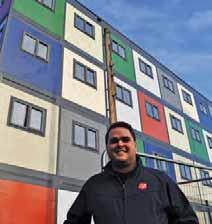
9 minute read
Viewpoint
Serving with a ‘glass half full’






Tony Daniels explains the advantages of asset-based approaches to service delivery Tony Daniels explains the advantages of asset-based approaches to service delivery
IT is no longer reasonable for social care or social work professionals or volunteers to assume a monopoly of knowledge or expertise in regard to the presenting needs of individuals and communities.
No longer are we primarily looking at deficits or problems that need fixing – rather, we are called to discern surfeits, local knowledge, resources, expertise and acumen that presents itself within an individual and community context. An asset-based approach to our service delivery means to always approach the individuals and communities we seek to serve with a ‘glass half full’ mentality. As people of faith and God’s Kingdom we are called by hope, and thereby called to imbibe, ignite and inspire the same in others – to look constantly for the good, the compassion, the joy, the creativity and the love in others.
This is the gold-standard aspiration for an asset-based approach through all expressions of The Salvation Army. Centralised services such as the Army’s Homelessness Services and Older People’s Services, in line with the wider, nationally mandated social care T is no longer reasonable for social care or social work professionals or volunteers to assume a monopoly of knowledge or expertise in regard to the presenting needs of individuals and communities. No longer are we primarily looking at deficits or problems that need fixing – rather, we are called to discern surfeits, local knowledge, resources, expertise and acumen that presents itself within an individual and community context. An asset-based approach to our service delivery means to always approach the individuals and communities we seek to serve with a ‘glass half full’ mentality. As people of faith and God’s Kingdom we are called by hope, and thereby called to imbibe, ignite and inspire the same in others –to look constantly for the good, the compassion, the joy, the creativity and the love in others. This is the gold-standard aspiration for an asset-based approach through all expressions of The Salvation Army. Centralised services such as the Army’s Homelessness Services and Older People’s Services, in line with the wider, nationally mandated social care, y
























































providers’ agenda, have sought to adopt fresh approaches, structures and semantics in their delivery. For example, moving towards methodologies such as ‘psychologically informed environments’, which seek to ensure that service users’ experiences and environments do not necessitate the constant retelling of negative or life-limiting narratives. Some of our corps community services – and other expressions within the Army – are still wrestling with the challenge of migrating from a gift-based model of service delivery. This model invokes sentiments such as ‘Be grateful for what you get from us’. It contrasts with the asset-based model, which invokes sentiments such as ‘What can we volunteers and professionals learn from your multi-layered experiences?’ and ‘How can we work together to harness the rich resources that lie within you and your community for the sake of the Kingdom?’
What this tends to mean in terms of the ‘daily grind’ of a corps or centre is that the asset-based approach is inextricably linked to its forerunner: the person-centred approach. That focuses on the individual’s personal needs,
wants, desires and goals, as they define them.
Both of these worthy and aspirational
methodologies are
delivered within a very nuanced continuum. Due to this, it is highly unlikely that many corps, expressions or centres that theoretically align their services or mission with assetbased or personcentred approaches will achieve a 100 per cent success rate in terms of consistently delivering against them.
The barriers to adopting an asset-based approach wants, desires and goals, as they define them.
Both of these worthy and aspirational methodologies are delivered within a very nuanced continuum. Due to this, it is highly unlikely that many corps, expressions or centres that theoretically align their services or mission with assetbased or personcentred approaches will achieve a 100 per cent success rate in terms of consistently delivering against them.
The barriers to adopting an asset-based approach providers’ agenda, have sought to adopt fresh approaches, structures and semantics in their delivery. For example, moving towards methodologies such as ‘psychologically informed environments’, which seek to ensure that service users’ experiences and environments do not necessitate the constant retelling of negative or life-limiting narratives. Some of our corps community services – and other expressions within the Army – are still wrestling with the challenge of migrating from a gift-based model of service delivery. This model invokes sentiments such as ‘Be grateful for what you get from us’. It contrasts with the asset-based model, which invokes sentiments such as ‘What can we volunteers and professionals learn from your multi-layered experiences?’ and ‘How can we work together to harness the rich resources that lie within you and your community for the sake of the Kingdom?’
What this tends to mean in terms of the ‘daily grind’ of a corps or centre is that the asset-based approach is inextricably linked to its forerunner: the person-centred approach. That focuses on the individual’s personal needs,p , wants desires and goals are attitudinal and not necessarily intentional. Primarily, the foundational paradigm needed is constant reflective practice. That is, possessing – or having a desire to develop – the ability and skill of continually asking searching questions about the power dynamics faced by those we seek to serve. For example, does our mentality towards individuals and communities foster a crucible for ‘divine alchemy’ that leads to transformation, interdependence and co-production, as opposed to the well-meaning, old school gift-based model interventions that do more harm than good?
Ultimately, we seek to listen hard to those within the marginalised communities we journey with. We hope with open and expectant hearts that they too share their goodness, kindness and hope on our paths.
Whatever comes out of hard listening and our desire to seek God’s will with individuals within our communities – namely, seeing Christ in them – it must result in services that are fully shaped by those we purport to serve. Could that be part of our genuine service and ministry to God? Is he not seeking those that worship in Spirit and truth?
Furthermore, doesn’t truth often speak to the heart of an issue – to the very core motives behind our service or worship, which have the potential to inadvertently beguile or liberate its beneficiaries? Is this perhaps why the apostle Paul suggests that in all our doings we should seek to walk circumspectly?
This is Kingdom business and serious stuff, especially when the God of the universe is entrusting us to display his Kingdom asset-based mentality to his creation.

TONY IS TERRITORIAL DIRECTOR FOR COMMUNITY SERVICES TONY IS TERRITORIAL DIRECTOR FOR COMMUNITY SERVICES






